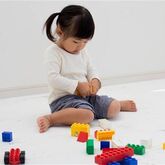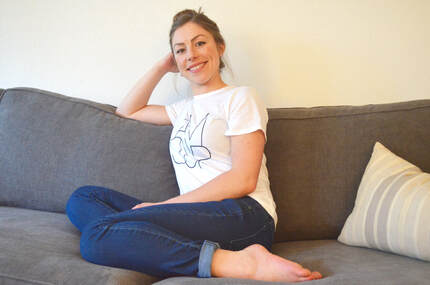 Doctors and pediatric healthcare professionals debate on how bad - or not so bad - W-sitting is for a child's anatomy and development. As a pediatric occupational therapist who specializes in teaching children how to use their bodies better, here is my take. First, let's talk about why it happens.
Children may be born with a slight internal rotation of their thighbones in relation to their hip joints, known as femoral anteversion. This causes a child's knees and feet to turn inward, or have what is also known as a "pigeon-toed" appearance. Typically, this hip rotation decreases through normal growth over time, and the thighbones straighten out. But until that happens, w-sitting can feel like a more natural position for their hips. Second, w-sitting can result from poor postural stability. Many kids with low core strength use the w-sit position because it provides a more stable base for upright sitting. With a wider and more stable base, they can reach out and move an arm away from midline without losing balance or fatiguing as quickly as they might sitting in tailor or long sit positions. Third, it can become a habit. Children are problem solvers, and they realize that it takes less muscle activation and achieves more stability. How smart of them! The brain learns this pattern, leading to increased frequency and preference for w-sitting. It becomes a default setting; natural and normal. Fourth, W sitting could be a result of some other underlying developmental delay. Although W-sitting is somewhat common for typically developing kids, it is more prevalent in children who have other disorders. It becomes a compensatory strategy for children experiencing a wider pattern of difficulties. Many doctors and healthcare professionals believe children naturally respond to their anatomy. If they want to sit in a W position, then there must not be any excessive stress on their hip joints, muscles, or knees. There is also no solid evidence that it causes orthopedic problems down the road. Although there are no proven anatomical or developmental risks of w-sitting, there are some things to consider... Most importantly, a compromised position of the pelvis. The pelvis is our base, our core platform, our foundation. It is the most important player in stable and healthy posture. If a child's pelvic position is off, their whole posture and anti-gravity mechanism will be too. W-sitting rotates the pelvis posteriorly, causing rounding in the spine and slouching. This leads to weakness and instability. Think of the pelvis, spine, and head as a tall stack of bricks. If the bottom brick (your pelvis) is not aligned properly, then the rest of the stack will be unstable. Other sitting positions encouraging anterior pelvic rotation (tailor sit, long sit, sitting on a bench) allow for the solid stacking of bones, and being "up." Establishing a strong anti-gravity response is hugely important for efficient, smooth, and organized movement. Another concern is limited trunk extensor activation. The wide base of support afforded by W-sitting requires less core muscle activation in trunk extensors and abdominals to maintain the position. This can result in core strength deficits due to compensating for more stability and balance in W-sit. The W-sit position also limits the child's need to shift weight from side to side, leading to decreased lateral and posterior balance reactions. W-sitting becomes a shortcut, the easy way out. Additionally, a posteriorly rotated pelvis and decreased trunk extension inadvertently limits upper-body rotation. The inability to exhibit trunk rotation during play can impair a child's ability to reach across their body with the opposite hand and cross midline. This impacts bilateral coordination, hand-eye coordination, and fine motor skill development. So, what should you do if you see your child W-sitting? 1. If you notice your child always W-sits on the ground, try moving toys and games to a table or easel. Structure their play activities in a way that incorporates different positions like standing, kneeling, squatting, sitting on a bench/stool, or lying on their bellies. 2. Build in games that involve balance and postural stability. Provide activities that require standing on one leg, squatting, jumping, running, throwing, and reaching with accuracy. As children get stronger and grow older, there is a good chance the W-sitting will resolve itself. But they will need the stability and strength built by balance and postural activities, so start early. 3. Consider how the child is growing and learning in all aspects of their development. If you notice a wider pattern of difficulty or delay, seek the help of a healthcare professional such as an occupational or physical therapist. In these cases, W-sitting is not the concern, but the larger picture of developmental difficulties may be.
0 Comments
Your comment will be posted after it is approved.
Leave a Reply. |
meet the bloggerAusten is a pediatric occupational therapist with experience in schools, early intervention, and private clinic settings. She now runs her own private practice in Portland, OR specializing in movement based learning techniques. This blog's mission is to educate and empower parents and children by sharing insights into the complexities of learning and development. Categories
All
|
MINDFUL MOVEMENT THERAPIES
In-Home Pediatric Occupational Therapy in Portland, Oregon
phone503-720-4634
|
|
|


